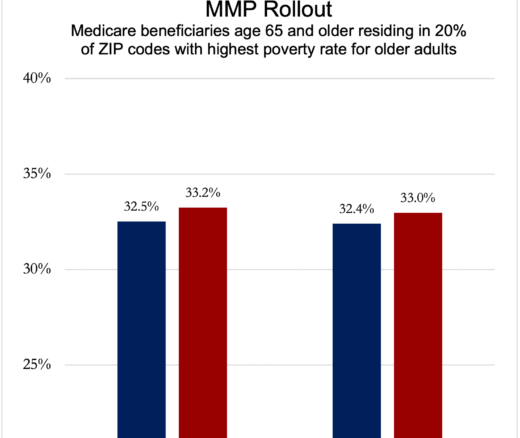
Integrated Care Plans Didn’t Boost Medicaid Enrollment for the Poorest Seniors
Chart of the Day: Medicare-Medicaid Plans—Created to Streamline Care for Dually Eligible Individuals—Failed to Increase Medicaid Participation in High-Poverty Communities
Blog Post

In the midst of a tense national debate over reproductive rights, it is crucial that all people━including adolescents━are able to access effective birth control to manage their reproductive health. Long-acting reversible contraception (LARC), such as intrauterine devices (IUD) and hormonal implants, are the most effective methods available and can provide up to several years of protection against unintended pregnancy. Yet only 4.3% of females aged 15 to 19 years use them.
A new study by LDI Fellows Polina Krass and Sarah Wood, and Pediatric Emergency Medicine Fellow Erin H. Sieke, and colleagues discovered one big reason why: In a national survey, only 13.6% of residents were comfortable with inserting contraceptive implants and just 6.3% with implanting IUDs.
It is critical that future pediatricians receive adequate training and support to administer these methods effectively. Why then, have so few received it? To dive deeper on this topic, I spoke with Drs. Krass and Sieke to understand more about their study and the importance of training for administering LARCs effectively:
Polina: A majority of teens see a pediatrician for their primary care, but most pediatricians are unable to provide the most effective forms of birth control. In our study, we found that the vast majority of pediatric residents want LARC training to be included in pediatric resident education, and currently very few residents feel comfortable providing this care.
Polina: I expected that survey participants who were planning on a career in primary care or adolescent medicine would be interested in this training, but that residents interested in other pediatric career paths, like cardiology or gastroenterology, might not think that the additional contraceptive training was needed. However, in our survey sample, the majority of residents who were planning on subspecialty training believed that pediatric residents should be trained in the insertion of LARC devices.
Erin: One of the findings that I was surprised by was that only a small percentage of pediatric residents interested in pursuing careers in primary care or adolescent medicine reported comfort placing LARC devices. This suggests a gap in resident’s education, where the most eager trainees do not have access to LARC training during pediatric residency.
Polina: Comprehensive training on adolescent sexual and reproductive health requires buy-in at the institutional level. Residency training programs and hospital leadership need to carve out time for residents to learn how to provide full-spectrum contraceptive services. Importantly, residents need to learn how to provide this care using a reproductive justice framework that recognizes the decades of reproductive coercion that have influenced our patients’ trust in the medical system, and empowers patients to make the family planning choices that are best for them.
From a procedural skill standpoint, programs can embed training into the pediatric residency curriculum so that all residents are comfortable with the basics. In settings where pediatricians may be less likely to provide these methods in clinic, it is important to develop partnerships with divisions that provide LARC methods more frequently, such as adolescent medicine, OB/GYN and Family Medicine, and create opportunities for residents to participate in outpatient visits in these settings to gain hands-on skills.
Polina: While IUDs and hormonal implants have been around for a long time, earlier designs had major problems. There were significant risks of infections with IUDs, and both IUDs and hormonal implants were more difficult to remove, leading to coercive situations where individuals had LARCs placed that they couldn’t remove. However, over the past 20 years, the field has changed radically. We now have devices that are extremely safe, easy to insert and remove, and not associated with infection.
In 2013, the Centers for Disease Control and Prevention started recommending LARC options for all ages, including adolescents, and since then the use of these methods has increased significantly. As more adolescents become interested in these methods, the pediatric workforce needs to build up the skills to provide this care.
Erin: Safe LARC options are relatively new in the contraceptive landscape for pediatric patients, so many practicing pediatricians may be unfamiliar with or uncomfortable with these methods. Since pediatric residents learn from pediatricians, we must find ways to support education to ensure a pipeline of providers trained to provide all contraceptive methods to their patients.
| For more on this topic, attend Penn LDI’s event “Impact of Medicaid Payment for Immediate Long-Acting Reversible Contraception on Postpartum Contraception, Birth Spacing and Infant Health” on May 25, 2023. |
Erin: The current political landscape of reproductive health care in the United States has huge implications for adolescents and their healthcare providers. The July 2022 Dobbs v. Jackson Women’s Health Organization decision, which overturned Roe v. Wade and allowed states to place harsher restrictions on abortion, led to surges in demand for emergency contraception, causing shortages. Some experts have suggested that birth control restrictions could follow abortion bans in many states. This highlights the importance of preventive health care━ adolescent patients are most likely to see a pediatrician for their reproductive health care needs, and pediatricians must be prepared to provide contraception that meets their needs.
Polina: Millions of adolescents now live in a state that limits abortion access, and more states are likely to impose restrictions moving forward. Furthermore, restrictions are actively being litigated that would prevent anyone in the U.S. from accessing mifepristone, one of two medicines commonly used for medication abortion.
There are also more insidious restrictions being rolled out. For example, teens in Texas no longer have access to confidential family planning services within the Title X program, a federal program that since 1970 provided access to confidential, low-cost or free family planning care. These restrictions on evidence-based care make it even more important that we decrease barriers to access contraception. If we can provide LARC devices in pediatric settings and save teens a visit to another provider, they are more likely to actually receive this care.
Polina: Reproductive justice is defined by the advocacy group SisterSong as “the human right to maintain personal bodily autonomy, have children, not have children, and parent the children we have in safe and sustainable communities.” All health care professionals need to understand the history of reproductive injustice and coercion in medicine, the downstream implications of these failings on medical trust, and how to integrate a reproductive justice framework in their contraceptive counseling. For pediatricians, it’s critical that we train these skills and reinforce them throughout residency so that youth moving forward are able to have judgment-free, empowering conversations with their doctors about their priorities in family planning.
Erin: Based on the results of this study, our pediatric residency program at CHOP was able to expand reproductive health education. All pediatric residents now participate during academic half days in protected didactic education that includes contraceptive counseling, reproductive justice, and Nexplanon procedural training. Pediatric residents then have the opportunity to place Nexplanons in primary care and outpatient adolescent medicine clinics to solidify these skills. In order to train pediatricians to provide comprehensive contraceptive care for adolescents, institutions must prioritize protected educational time to allow for the development of these skills.
The study, “Pediatric Resident Perspectives on Long-Acting Reversible Contraception Training: A Cross-Sectional Survey of Accreditation Council for Graduate Medical Education Trainees” was published on March 10, 2023 in the Journal of Adolescent Health. Authors include Polina Krass, Erin H. Sieke, Priyanka Joshi, Aletha Y. Akers, and Sarah M. Wood.


Chart of the Day: Medicare-Medicaid Plans—Created to Streamline Care for Dually Eligible Individuals—Failed to Increase Medicaid Participation in High-Poverty Communities
Research Brief: Shorter Stays in Skilled Nursing Facilities and Less Home Health Didn’t Lead to Worse Outcomes, Pointing to Opportunities for Traditional Medicare

How Threatened Reproductive Rights Pushed More Pennsylvanians Toward Sterilization

Abortion Restrictions Can Backfire, Pushing Families to End Pregnancies

They Reduce Coverage, Not Costs, History Shows. Smarter Incentives Would Encourage the Private Sector
Research Brief: Less Than 1% of Clinical Practices Provide 80% of Outpatient Services for Dually Eligible Individuals